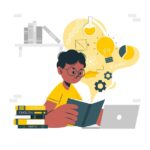Two News Stories From Abroad Suggest American Education Is On The Wrong Track

News about schools in England and Finland challenge a prevailing assumption in American education–that it’s better for students to learn on their own than to be explicitly taught.
GETTY
It can be risky to look to other countries’ education systems for models. Nevertheless, two recent news stories from abroad raise doubts about prevailing American views on how students learn.
Too often, American education reformers and policymakers have called for emulating other seemingly successful systems without taking into account the myriad differences between any two countries. An approach that has worked in one place won’t necessarily produce the same results in another.
Still, cognitive science has revealed certain principles that underlie the basic human learning process. For example, it’s well established that, especially when students don’t know much about a topic, the most effective pedagogical approach is explicit instruction—having the teacher directly provide basic information.
But prospective teachers in the United States and some other English-speaking countries learn the opposite. In those countries, schools of education have long inculcated a philosophy called progressivism or constructivism. One of its basic tenets is that it’s best for children to learn on their own as much as possible, on the theory that they need to discover or construct knowledge for themselves rather than to have a bunch of facts poured into their brains. Progressive educators say explicit instruction not only fails to provide children with meaningful knowledge and skills, it also renders them bored and miserable. Rather than having the teacher talk, the argument goes, it’s better for students to learn through inquiry, projects, and largely self-guided group work.
Few if any schools embrace one of these approaches to the exclusion of the other. Virtually any teacher, no matter how “progressive,” provides some information directly. Similarly, even the most “traditional” teachers undoubtedly allow for some inquiry and knowledge-construction on the part of their students. It’s more a question of where the balance lies and what teachers feel they should be doing. And two developments in other countries this past week suggest a system skewed heavily towards progressivism doesn’t work well for many students.
The first of these stories comes from England, where the tenets of progressive education are just as entrenched as in the U.S. A former teacher named Katharine Birbalsingh once told me that when government inspectors made one of their periodic visits to the London school where she worked, the head of the school would caution teachers, “Now whatever happens, we cannot have a situation where the teacher is teaching and the students are listening!”
Five years ago Birbalsingh founded a new school, the Michaela Community School, that embraces the idea that the teacher should stand in front of a class and explicitly impart information. The school also enthusiastically flouts other progressive education tenets: students are required to memorize historical dates and poetry, for example, and homework consists largely of self-quizzing. In England, Michaela has been the target of a barrage of criticism, focused mainly on its strict disciplinary system. As in some American charter schools, students are required to be silent in the corridor while changing classes and are penalized for infractions like rolling their eyes or “persistently turning around in class.” (Michaela is a “free school,” the English equivalent of a charter school.)
When I visited Michaela a couple of years ago, the school was still too new to have test results. But I saw no sign that children were suffering. When I arrived at lunchtime, I—like all of Michaela’s many visitors—was invited to sit at any table, each of which had six students. The ones I sat with, who were in the equivalent of 6th grade, were either genuinely happy and proud of how much they were learning or else they were incredibly skillful actors. In the classes I visited, kids seemed eager and engaged. And a month after my visit, government inspectors issued a report declaring the school “outstanding” in all categories.
The news this week was that Michaela had gotten its first round of results on national exams known as the GCSEs, taken by students when they’re 15 or 16. Michaela’s students, all of them low-income and many of color, did far better than the national average: 18% of the exams received the top grade, a 9, as compared to 4.5% of exams nationwide; 54% received a 7, 8, or 9—equivalent to an A or A+—as opposed to the national average of 22%. Watching video clips of Michaela students shedding tears of joy as they saw their scores, I found it hard not to shed a few myself.
Last week’s other foreign education news story came from Finland, which has been the subject of admiration since 2000, when its students came out at or near the top on international exams known as the PISA. Education reformers, often of the progressive stripe, attributed that success to what seemed to be a decentralized system that granted teachers a high degree of autonomy and respect and downplayed testing.
But that’s just what the system looked like in the early 2000s. Reformers overlooked the fact that in earlier years, there had been quite a bit of centralized control, down to mandated textbooks and specified numbers of minutes per subject. That, in fact, was the fairly traditional system in which the 15-year-olds who took the PISA in 2000 had spent much of their school careers.
Since 2000, Finland’s PISA scores have experienced a gradual but fairly steady decline. Partly out of concern about the trend, in 2016 the government adopted a new national core curriculum that explicitly embraced the principles of progressive education that outsiders assumed it had been following all along. As described in a magazine published by the largest American teachers’ union, the NEA, the new curriculum “requires that teachers move away from subject-based, teacher-centered instruction toward interdisciplinary, student-centered teaching.” Students are to take a more active role. “The simple idea here,” one Finnish educator has explained, “is that teachers should talk less and let the student do more.”
Last week’s news story focused on complaints about one Finnish elementary school, an early adopter of the new approach, where students are expected to take responsibility for creating and adhering to their own personal weekly plans and remembering the dates of exams and deadlines. One 6th-grader—a girl named Aino, who has mild memory difficulties as a result of childhood epilepsy—found these expectations impossible to meet. But perhaps she’s not alone. Even high school students can have trouble taking on this kind of responsibility, perhaps because the adolescent brain is not yet ready for the challenge.
The article mentioned that several parents had moved their children to more traditional schools, but the only child mentioned by name was Aino. The most difficult thing for her, according to the article, was “the lack of teaching.”
“It was hard for me that the teacher did not teach at first, but instead we should have been able to learn things by ourselves,” Aino said. “I didn’t learn anything.”
Aino’s mother observed that the child’s feelings of failure “affected her self-esteem.” At Aino’s new, more traditional school, the mother said, “Joy and serenity returned to her life.” And she didn’t require any special support for her memory problems.
Clearly, two news stories about two schools aren’t definitive proof of anything. But last year, a researcher at Helsinki University warned that the new Finnish curriculum—which also encourages greater use of electronic devices—was having negative effects, especially for students with less self-discipline and less support from home. “Proponents of this method have claimed it would even out the differences between students with various [academic] backgrounds,” the researcher observed. “But in light of the research it looks like exactly the opposite has happened.”
The same could be said of a lot of progressive methods. They can work well for conscientious self-starters who have already managed to acquire a fair amount of academic knowledge—perhaps from their well-educated parents. But arguably, those students will learn no matter what methods are used. Schools need to take into account the far greater number of children who will only thrive with explicit instruction. Otherwise, an approach that is intended to provide children with a joyful and confidence-building academic experience can end up resulting in quite the opposite.
[“source=forbes”]




